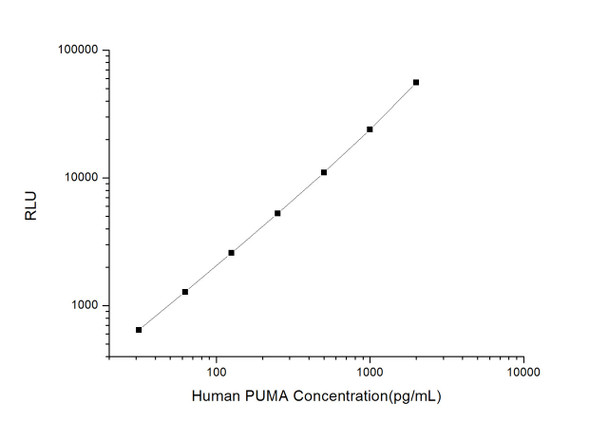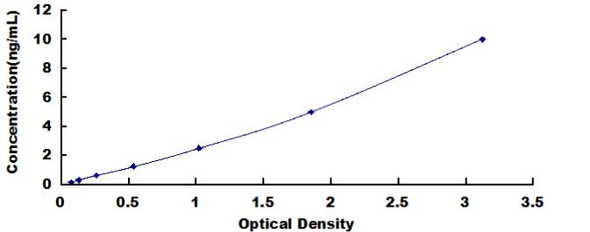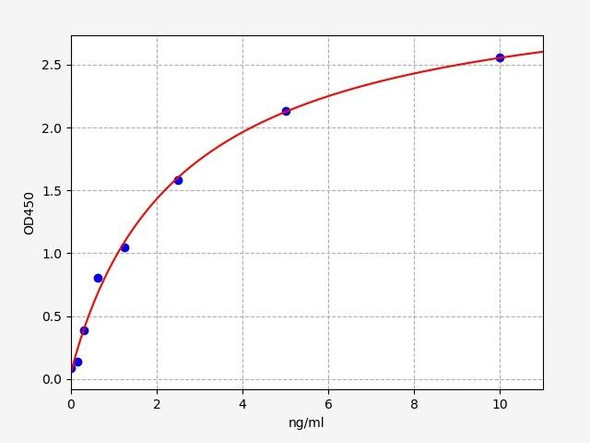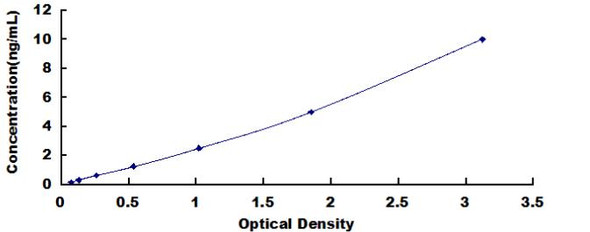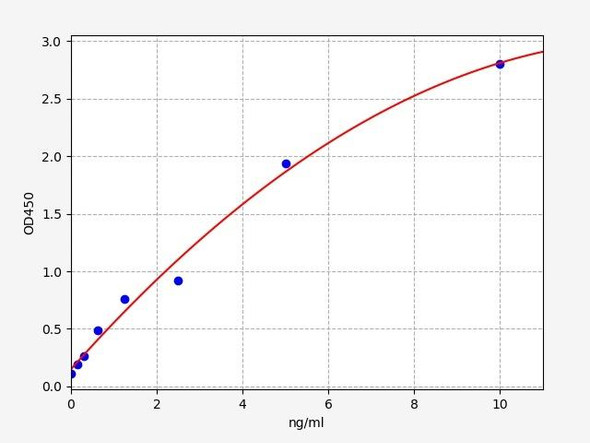Human Cell Death ELISA Kits
Human PUMA (P53 Upregulated Modulator of Apoptosis) CLIA Kit (HUES00816)
- SKU:
- HUES00816
- Product Type:
- ELISA Kit
- ELISA Type:
- CLIA Kit
- Size:
- 96 Assays
- Sensitivity:
- 18.75pg/mL
- Range:
- 31.25-2000pg/mL
- ELISA Type:
- Sandwich
- Reactivity:
- Human
- Sample Type:
- Serum, plasma and other biological fluids
- Research Area:
- Cell Death
Description
| Assay type: | Sandwich |
| Format: | 96T |
| Assay time: | 4.5h |
| Reactivity: | Human |
| Detection method: | Chemiluminescence |
| Detection range: | 31.25-2000 pg/mL |
| Sensitivity: | 18.75 pg/mL |
| Sample volume: | 100µL |
| Sample type: | Serum, plasma and other biological fluids |
| Repeatability: | CV < 15% |
| Specificity: | This kit recognizes Human PUMA in samples. No significant cross-reactivity or interference between Human PUMA and analogues was observed. |
This kit uses Sandwich-CLIA as the method. The micro CLIA plate provided in this kit has been pre-coated with an antibody specific to Human PUMA. Standards or samples are added to the appropriate micro CLIA plate wells and combined with the specific antibody. Then a biotinylated detection antibody specific for Human PUMA and Avidin-Horseradish Peroxidase (HRP) conjugate are added to each micro plate well successively and incubated. Free components are washed away. The substrate solution is added to each well. Only those wells that contain Human PUMA, biotinylated detection antibody and Avidin-HRP conjugate will appear fluorescence. The Relative light unit (RLU) value is measured spectrophotometrically by the Chemiluminescence immunoassay analyzer. The RLU value is positively associated with the concentration of Human PUMA. The concentration of Human PUMA in the samples can be calculated by comparing the RLU of the samples to the standard curve.
| UniProt Protein Function: | PUMA: Essential mediator of p53/TP53-dependent and p53/TP53- independent apoptosis. Interacts with MCL1 and BCL2A1. Interacts with BCL2 and BCL2L1/BCL-XL. By DNA damage, glucocorticoid treatment, growth factor deprivation and p53/TP53. Ubiquitously expressed. Belongs to the Bcl-2 family. 4 isoforms of the human protein are produced by alternative splicing. |
| UniProt Protein Details: | Protein type:Mitochondrial Chromosomal Location of Human Ortholog: 19q13. 3-q13. 4 Cellular Component: mitochondrial outer membrane; mitochondrion; cytosol Molecular Function:protein binding Biological Process: caspase activation; release of cytochrome c from mitochondria; positive regulation of protein homooligomerization; apoptosis; reduction of endoplasmic reticulum calcium ion concentration; positive regulation of neuron apoptosis; release of sequestered calcium ion into cytosol; determination of adult life span; response to DNA damage stimulus; negative regulation of growth |
| NCBI Summary: | This gene encodes a member of the BCL-2 family of proteins. This family member belongs to the BH3-only pro-apoptotic subclass. The protein cooperates with direct activator proteins to induce mitochondrial outer membrane permeabilization and apoptosis. It can bind to anti-apoptotic Bcl-2 family members to induce mitochondrial dysfunction and caspase activation. Because of its pro-apoptotic role, this gene is a potential drug target for cancer therapy and for tissue injury. Alternative splicing results in multiple transcript variants. [provided by RefSeq, Dec 2011] |
| UniProt Code: | Q9BXH1 |
| NCBI GenInfo Identifier: | 56748610 |
| NCBI Gene ID: | 27113 |
| NCBI Accession: | Q9BXH1. 1 |
| UniProt Secondary Accession: | Q9BXH1,O00171, Q96PG9, B9EGI3, |
| UniProt Related Accession: | Q96PG8,Q9BXH1 |
| Molecular Weight: | 193 |
| NCBI Full Name: | Bcl-2-binding component 3 |
| NCBI Synonym Full Names: | BCL2 binding component 3 |
| NCBI Official Symbol: | BBC3 |
| NCBI Official Synonym Symbols: | JFY1; PUMA; JFY-1 |
| NCBI Protein Information: | bcl-2-binding component 3; p53 up-regulated modulator of apoptosis |
| UniProt Protein Name: | Bcl-2-binding component 3 |
| UniProt Synonym Protein Names: | JFY-1; p53 up-regulated modulator of apoptosis |
| Protein Family: | Bcl-2-binding component |
| UniProt Gene Name: | BBC3 |
| UniProt Entry Name: | BBC3_HUMAN |
As the RLU values of the standard curve may vary according to the conditions of the actual assay performance (e. g. operator, pipetting technique, washing technique or temperature effects), the operator should establish a standard curve for each test. Typical standard curve and data is provided below for reference only.
| Concentration (pg/mL) | RLU | Average | Corrected |
| 2000 | 51062 60380 | 55721 | 55693 |
| 1000 | 23857 24091 | 23974 | 23946 |
| 500 | 11932 10132 | 11032 | 11004 |
| 250 | 5231 5357 | 5294 | 5266 |
| 125 | 2764 2452 | 2608 | 2580 |
| 62.5 | 1312 1310 | 1311 | 1283 |
| 31.25 | 671 677 | 674 | 646 |
| 0 | 27 29 | 28 | -- |
Precision
Intra-assay Precision (Precision within an assay): 3 samples with low, mid range and high level Human PUMA were tested 20 times on one plate, respectively.
Inter-assay Precision (Precision between assays): 3 samples with low, mid range and high level Human PUMA were tested on 3 different plates, 20 replicates in each plate.
| Intra-assay Precision | Inter-assay Precision | |||||
| Sample | 1 | 2 | 3 | 1 | 2 | 3 |
| n | 20 | 20 | 20 | 20 | 20 | 20 |
| Mean (pg/mL) | 97.88 | 189.88 | 808.92 | 105.48 | 199.47 | 840.14 |
| Standard deviation | 8.09 | 13.92 | 56.62 | 9.92 | 21.98 | 64.61 |
| C V (%) | 8.27 | 7.33 | 7.00 | 9.40 | 11.02 | 7.69 |
Recovery
The recovery of Human PUMA spiked at three different levels in samples throughout the range of the assay was evaluated in various matrices.
| Sample Type | Range (%) | Average Recovery (%) |
| Serum (n=5) | 90-104 | 95 |
| EDTA plasma (n=5) | 93-111 | 101 |
| Cell culture media (n=5) | 94-108 | 102 |
Linearity
Samples were spiked with high concentrations of Human PUMA and diluted with Reference Standard & Sample Diluent to produce samples with values within the range of the assay.
| Serum (n=5) | EDTA plasma (n=5) | Cell culture media (n=5) | ||
| 1:2 | Range (%) | 96-107 | 84-98 | 102-119 |
| Average (%) | 101 | 91 | 108 | |
| 1:4 | Range (%) | 94-110 | 102-118 | 99-117 |
| Average (%) | 102 | 109 | 107 | |
| 1:8 | Range (%) | 86-100 | 90-106 | 89-103 |
| Average (%) | 92 | 96 | 96 | |
| 1:16 | Range (%) | 96-108 | 104-119 | 91-101 |
| Average (%) | 102 | 110 | 96 |
An unopened kit can be stored at 4°C for 1 month. If the kit is not used within 1 month, store the items separately according to the following conditions once the kit is received.
| Item | Specifications | Storage |
| Micro CLIA Plate(Dismountable) | 8 wells ×12 strips | -20°C, 6 months |
| Reference Standard | 2 vials | |
| Concentrated Biotinylated Detection Ab (100×) | 1 vial, 120 µL | |
| Concentrated HRP Conjugate (100×) | 1 vial, 120 µL | -20°C(shading light), 6 months |
| Reference Standard & Sample Diluent | 1 vial, 20 mL | 4°C, 6 months |
| Biotinylated Detection Ab Diluent | 1 vial, 14 mL | |
| HRP Conjugate Diluent | 1 vial, 14 mL | |
| Concentrated Wash Buffer (25×) | 1 vial, 30 mL | |
| Substrate Reagent A | 1 vial, 5 mL | 4°C (shading light) |
| Substrate Reagent B | 1 vial, 5 mL | 4°C (shading light) |
| Plate Sealer | 5 pieces | |
| Product Description | 1 copy | |
| Certificate of Analysis | 1 copy |
- Set standard, test sample and control (zero) wells on the pre-coated plate and record theirpositions. It is recommended to measure each standard and sample in duplicate. Note: addall solutions to the bottom of the plate wells while avoiding contact with the well walls. Ensuresolutions do not foam when adding to the wells.
- Aliquot 100µl of standard solutions into the standard wells.
- Add 100µl of Sample / Standard dilution buffer into the control (zero) well.
- Add 100µl of properly diluted sample (serum, plasma, tissue homogenates and otherbiological fluids. ) into test sample wells.
- Cover the plate with the sealer provided in the kit and incubate for 90 min at 37°C.
- Aspirate the liquid from each well, do not wash. Immediately add 100µL of BiotinylatedDetection Ab working solution to each well. Cover the plate with a plate seal and gently mix. Incubate for 1 hour at 37°C.
- Aspirate or decant the solution from the plate and add 350µL of wash buffer to each welland incubate for 1-2 minutes at room temperature. Aspirate the solution from each well andclap the plate on absorbent filter paper to dry. Repeat this process 3 times. Note: a microplatewasher can be used in this step and other wash steps.
- Add 100µL of HRP Conjugate working solution to each well. Cover with a plate seal andincubate for 30 min at 37°C.
- Aspirate or decant the solution from each well. Repeat the wash process for five times asconducted in step 7.
- Add 100µL of Substrate mixture solution to each well. Cover with a new plate seal andincubate for no more than 5 min at 37°C. Protect the plate from light.
- Determine the RLU value of each well immediately.

